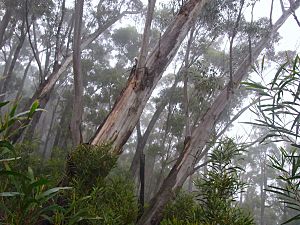Jillaga ash facts for kids
Quick facts for kids Jillaga ash |
|
|---|---|
 |
|
| Jilliga ash, Deua National Park, Australia | |
| Scientific classification | |
| Genus: |
Eucalyptus
|
| Species: |
stenostoma
|
The Jillaga ash (scientific name: Eucalyptus stenostoma) is a special type of tree found only in a small part of New South Wales, Australia. It's a small to medium-sized tree with unique features.
This tree has rough, dark bark on its lower trunk. Higher up, its bark is smooth and creamy white. It has long, spear-shaped adult leaves. Its white flowers grow in groups, and its fruit is round with a small opening.
Contents
What the Jillaga Ash Looks Like
The Jillaga ash is a tree that can grow up to 25 meters (about 82 feet) tall. It often has a trunk that leans a bit. This tree can also regrow from a special woody base called a lignotuber if it gets damaged.
Its bark is rough and dark gray or black on the lower part of the trunk. This bark has cracks and short fibers. Higher up, the bark is smooth and can be white or yellow. It often has wiggly lines made by insects and peels off in long strips.
Leaves and Flowers
Young Jillaga ash plants have leaves that are green to grayish. These leaves are slightly lighter on the underside. They can be shaped like an egg or a spear, growing up to 18 centimeters (about 7 inches) long and 6 centimeters (about 2.4 inches) wide.
Adult leaves grow one after another along the stem. They are shiny green and shaped like a spear or slightly curved. These leaves can be 9 to 19.5 centimeters (about 3.5 to 7.7 inches) long and 1 to 3 centimeters (about 0.4 to 1.2 inches) wide. Each leaf has a stem called a petiole that is 1 to 2 centimeters (about 0.4 to 0.8 inches) long.
The flower buds grow in the spots where leaves meet the stem. They appear in groups of 13 to 19 or even more. These groups are on a single stalk, or peduncle, that is 1.5 to 3 centimeters (about 0.6 to 1.2 inches) long. Each individual bud has a small stem, or pedicel, that is 0.4 to 1 centimeter (about 0.16 to 0.4 inches) long.
Mature buds are oval-shaped, about 0.5 to 0.6 centimeters (about 0.2 to 0.24 inches) long and 0.3 to 0.4 centimeters (about 0.12 to 0.16 inches) wide. They have a cap, called an operculum, that can be cone-shaped or rounded. The Jillaga ash blooms in the summer, and its flowers are white.
Fruit and Seeds
After flowering, the tree produces fruit. The fruit is a woody, round capsule. It has a slightly waxy, grayish-blue coating, which is called glaucous. The fruit is 0.7 to 1.2 centimeters (about 0.28 to 0.47 inches) long and 0.6 to 1.2 centimeters (about 0.24 to 0.47 inches) wide. The parts that open to release the seeds, called valves, are tucked inside the rim of the fruit.
How the Jillaga Ash Got Its Name
The Jillaga ash was first officially described in 1972. Two scientists, Lawrie Johnson and Donald Blaxell, gave it its scientific name. They wrote about it in a publication called Contributions from the New South Wales Herbarium.
The first samples of the tree, called type specimens, were collected in 1965. They were found by David John Hynd near the top of the Tuross River, not far from Nerrigundah.
The second part of the tree's scientific name, stenostoma, comes from two ancient Greek words. "Steno" means "narrow," and "stoma" means "opening." This name refers to the small opening found on the fruit of the Jillaga ash.
Where the Jillaga Ash Lives
The Jillaga ash grows only in specific areas of New South Wales, Australia. You can find it in the catchment areas (the land that collects water) of the Tuross and Deua Rivers.
It prefers to grow on steep slopes in dry woodlands. The soil in these areas is usually not very rich in nutrients. Even though it can be hard to find, the Jillaga ash is quite common in some of these specific locations.
Images for kids





